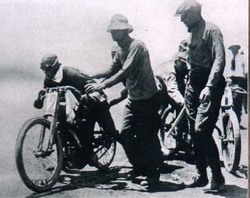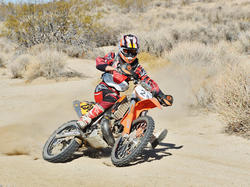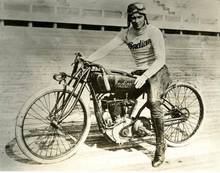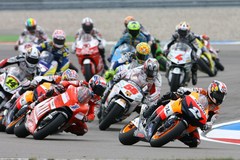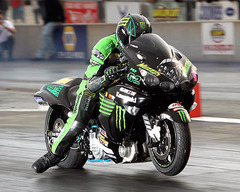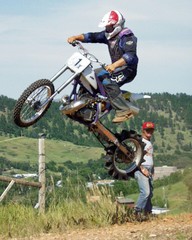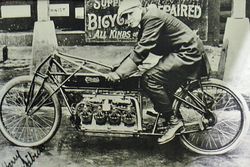An Overview of Motorcycle Racing:
Motorcycle racing grows more complex every decade:
The history of motorcycle racing goes back to the first two guys who wanted to see who had the fastest machine. From that race forward racing was an ever expanding and always growing in complexity. All racing from the earliest years were developments of off road varieties of racing, racing on surfaced tracks, specialty races which focus on a specific type of machine or a particular type of surface, or racing with a single focus like drag racing or racing on ice. The new Super Moto type racing (or Dakar) simply mixes a number of elements from other types of racing. This is a simplification but is a broad brushstroke of motorcycle racing.
(I) The first type of motorcycle racing was dirt track or various forms of "off road racing on unpaved surfaces." This was the earliest form of racing because in the early days, there were very few paved roads. Old horse racing tracks were just converted to motorcycle racing. Off road racing includes:
- dirt track (oval dirt tracks)
- motocross (a course which includes curves and streightaways)
- hare scrambles (off road racing over specific courses of mixed terain)
- supercross (motocross with high jumps)
- enduro (really rough terain requiring a great deal of endurance)
- speedway (high speed flat dirt track)
- grass track (scrambles on a grassy surface)
- trials (track with extreme obstacles and rough terrain)
Pictured above and below are dirt track racers from the past and from today!
(II) The second basic type of motorcycle racing is road racing which is "racing on paved surfaces." Road racing did not exist till there were paved roads in which to race on. The basic types are:
- board track (before surfaced roads, wood was used to create tracks typically in ovals and with banked corners)
- grand prix racing (high speed track racing)
- superbike (high speed modern sport bike racing)
- Moto GP (high end super bike)
- super course (general term for racing on specific tracks in detailed categories)
Pictured above is an old board track racer. The board tracks operated from around 1910 and ended by the early 1930's. So many riders were maimed, seriously hurt, and even killed. The tracks were cammed "murderdomes." The board tracks were the first tracks with a surface.
The picture above is vintage and the lower picture is more modern;
Drag racing didn't really begin till after the WWII period. A drag bike built from a modified street bike can travel the quarter mile in under eight seconds and approach 180 mph by the end of the track.
(III) The third basic type(s) of racing could be placed under Specialty Classes. These include hill climbing, drag racing, landspeed racing, ice racing, sidecar racing, and vintage motorcycle racing. All of these classes are based on racing on specific surfaces (hills, mud, on ice, etc.), speed related goals (drag racing landspeed racing, cross country, etc.), and racing with specific handicaps (sidecar, vintage racing, or on mixed surfaces).
- hill climbing (racing up steep inclines)
- drag racing (quickest time in an eighth or quarter mile)
- landspeed racing (highest speed)
- ice racing (racing on ice)
- sidecar racing (attached sidecar of various sorts)
- vintage (racing on older machines)
- motard (racing on different types of surfaces in one race)
- distance related classes (cross country or over long distances)
A modern "hillclimber" in action.
What I have described above is certainly oversimplified but is basically accurate. There could be 40 different classes of road racing on a specific track. There could be a 50cc class, a 125cc class, a 250cc class, a 500cc class, a 350cc class, a 500cc class, a 750cc class, a 1000cc class or open sized class. Within each of those designations, there could be many specific variations. A single cylinder 500 might be able to race in the multi cylinder 350 class or a larger "side valve" engine may be able to race with smaller "OHC" engines. Classes may include types of fuels, fairing types, or engine types. The variations are growing on a regular basis along with continually growing sub classes. There are yearly changes as well as some classes dissappearing completly. There are even specific races within certain continents or on specific tracks. The basic categories, however, do not change. Either the race is on off road surfaces, paved surfaces, a mixture of the two, or is based around very specific limitations. For examble drag racing could be on a paved surface, in the mud, or on sand. Road racing could be on a large oval track, a three mile course, blocked off public streets, or around a designated area. Technology determines some classes, fuels may determine other classes, and the style of riding may determine other classes. The goals are simple, to go faster around a course, to go faster down a streight line, to go the "fastest" period, or to go over really rough terrain in the shortest amount of time. Challenging the boundaries with very specific limitations is the ultimate goal. Most racing, like other sports, is often dependent on minute limitations. One hundreth of a second determines the winner from the looser in a race! Often, the battle over minute rules makes or breaks a class of racer. These are the boundaries which are always being fought and will never change. In fact, as time goes forward, more and more regulations slip into every type of race. In 10 years, there will undoubtidly be new races unknown of today.
The first V-8 motorcycle, the 1907 Curtiss:
Glenn Curtiss, of airplane fame, was the first man to put a V-8 engine in a motorcycle. He exceeded 136 mph in 1907 which was a speed beyond belief at that time. The effort to beat existing speed records is an ongoing battle. Speed week at the Bonneville Salt Flats in Utah is the place where world records are broken. The current record for an actual motorcycle is just under 400mph. Cars are of course much faster because of high speed stability. The fastest vehicles are just jets without the wings! At the time of this writing, speeds of over 1,000 mph have been achieved.
